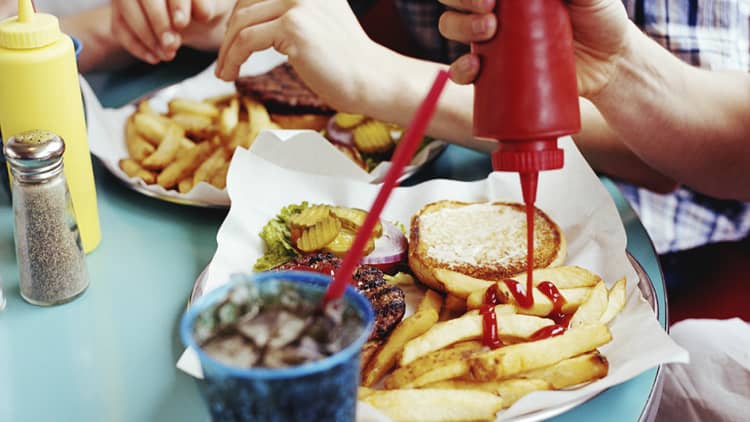Brace yourself: the price hike at Shake Shack isn't the only one you're going to see this year. From burgers to pizza, consumers are going to be paying more for meals in 2017, thanks to minimum wage increases.
"What we are seeing is that there is an increase in restaurant operators who are taking price increases and the number one reason relates to labor," Darren Tristano, CEO of Technomic, told CNBC.
Tristano said that normal price inflation is about 2 percent to 2.5 percent, but that consumers could see prices up as much as 5 percent.
In Chicago, for example, minimum wages are rising to $10 an hour from $8.25, he said.
"That's a 25 percent increase," Tristano said. "And labor is generally about 25 to 30 percent of the cost of a restaurant. So, if a quarter of your cost is going up 25 percent, that's a significant amount, it's going to result in maybe a 5 percent cost increase on just labor hitting the bottom line. It's just math unfortunately."
Danny Meyer's burger joint hiked some of its menu prices by up to 36 cents last month as it continues to work to better compensate its employees. This translated to an about 1.8 percent price hike, according to Eater.
Fast food chains, in particular, will feel more pressure to increase prices, as they typically have had lower labor costs in the past, he added.
Whereas, fast casual restaurants like Starbucks, Chick-fil-A and In-and-Out Burger already have higher wages and will feel less pressure. Independent chains, fine dining locations and restaurants that rely on tip-based wages also fit into this category.
"First and foremost, it's not a surprise the minimum wage is going up," Michael Mabry, chief operating offier of Mooyah Burgers, told CNBC. "So, we've had months, if not all year, to plan for it."
Mabry noted that his company has been able to negotiate with vendors to keep the cost of its three main products — beef, bread and potatoes — flat or lower. In fact, the restaurant is actually decreasing the prices of several items including its small french fries and regular sized drinks, two of its most popular check add-ons.
"As we look at minimum wage, it's just the cost of doing business," Mabry said. "Every time that there's going to be a wage increase or some time of cost of good increase, I believe that you can't pass that along to the guest every time. If you do that, you are going to out price yourself...We look at the whole picture and not just that one line item."
Franchised restaurants can have a harder time dealing with minimum wage hikes because the company doesn't have as much control over how franchisees operate their stores.
Pita Pit's president Peter Riggs told CNBC that it's important for restaurants to have a strong corporate culture so that franchisees understand the values of the company's executives.
"Pita Pit understands the value of our in-store employees and the importance of them because they are the true representatives of our brand, dealing face-to-face with our customers when they walk through the door," Riggs said. "So we try to make sure that all of our employees feel like they are compensated fairly."
Riggs noted that "price increases are sometimes a necessary strategy," but that Pita Pit works to reduce overhead costs for its franchisees so that the operators won't have raise prices and are able to pay employees appropriately.
Bonnie Riggs, an analyst with the NPD Group, who has no relation to Pita Pit's Riggs, noted that the last time restaurants raised prices too much the industry saw traffic and sales plummet. She is seeing that happen again.
"Restaurant operators continue to take price and if they continue to take price, and not take it selectively... the consumer will reject them," NPD's Riggs told CNBC. "Evaluate your menu, take price on those things where your margins are better, but to take an across-the-board increase is almost like a kiss of death in today's market, because we continue to deal with a cautious and controlled spending consumer."
The restaurant industry has been plagued with choppy sales and soft traffic throughout 2016, the result of "having more restaurants than bodies to fill them," Riggs said.
While the growth in the number of diners has remained steady at about 1 percent per year since 2010, restaurant traffic came to a standstill in the first two quarters of 2016 and then turned slightly negative in the third quarter. Results aren't in for the fourth quarter, but expectations are for similar trends.
In order for restaurants to succeed in this saturated market, they must give consumers a "compelling reason" to visit, Riggs added. Brand loyalty, quality customer service and quality food will drive traffic and sales.
Riggs points to Domino's and Chick-fil-A as chains that have been very successful at enticing repeat customers.
"The thing of it is, the market has become so fragmented that your competition is not just the next restaurant down the street," she said, adding that consumers have more choices now when they want to buy a prepared meal.
WATCH: 2017 Playbook: Restaurants looks for a renaissance



